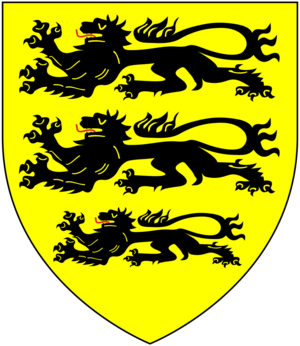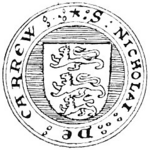Nicholas Carew (died 1311) facts for kids


Nicholas Carew (died 1311) was an important nobleman in medieval England. He was known as the Lord of Moulsford. He also played a part in the Wars of Scottish Independence, which were conflicts between England and Scotland.
Nicholas Carew was a powerful feudal lord. This meant he controlled large areas of land. He was the lord of Carew Castle in Pembrokeshire, Wales. He also held land in Ireland called Odrone (now Idrone). In England, he was the lord of the manor of Moulsford in Berkshire.
He was a soldier and a very important person in his time. Nicholas was the first of the Carew family to connect with the county of Devon. His family became very famous there. Later, his descendants received several special titles. These included three Carew baronetcies and four peerage titles. A peerage title means you are a member of the nobility.
Contents
Family Background
Nicholas Carew was the oldest son of Nicholas de Carew, who died in 1297. His father was also the feudal lord of Carew Castle. He was also the lord of Moulsford. Nicholas's mother was Avice Tuitt. Her family had gained control of the Barony of Odrone in Ireland.
His Important Career
Nicholas Carew was one of 103 important people who signed the Barons' Letter of 1301. This letter was sent to Pope Boniface VIII. The Pope claimed he had power over Scotland. But the letter told him that England's King Edward I was the true ruler of Scotland. Nicholas signed the letter as "Nicholas de Carew, Lord of Moulsford."
Was He a Baron?
In 1300–1301, King Edward I asked Nicholas to come to Parliament. This was done by a special order called a writ. Because of this, some people believe he became a Baron Carew. A baron is a noble who can attend Parliament.
However, it's not completely clear if he officially held the title "Baron Carew" in the same way later barons did. Some historical records call him "Baron Carew." But official lists of peerage titles from that time don't always mention it. Still, he was clearly a very important figure. He was one of the few who signed the famous Barons' Letter to the Pope.
The Caerlaverock Roll
In 1301, Nicholas Carew was at the Siege of Caerlaverock Castle in Scotland. During this siege, English heralds (people who study coats of arms) wrote down the descriptions of the knights' armorials. These were the special symbols on their shields and banners. This list is known as the Caerlaverock Roll of Arms.
Nicholas Carew's arms were described in French verse:
- A brave and famous man
- With him, Nicholas de Carew,
- Whose deeds often appeared
- In secret and in the open
- Against the fierce people of Ireland;
- He had a good yellow banner,
- With three black lions walking.
This means his banner was yellow with three black lions walking across it. These are the same lions seen on the Carew family's coat of arms.
Marriage and Children
Nicholas Carew married Amicia (or Amy) Peverell. She was the daughter of Hugh Peverell, who was the lord of the manor of Ermington in Devon. Amicia inherited her brother's lands, as he had no sons.
Nicholas and Amicia had several children, including:
- John Carew (died 1324): He was their oldest son and heir. John married twice.
- His first wife was Elinor de Mohun. They had a son named Nicholas Carew (died 1323). This younger Nicholas married Elinor Talbot but died without children.
- John's second wife was Joan Talbot. They had a son named John Carew (died 1363). This John inherited Mohuns Ottery, which became a very important home for the Carew family.
- Thomas de Carew (died 1331)
- William de Carew (died 1359): He died without children.
- David de Carew
Another important person, Nicholas Carew (died 1390), is sometimes thought to be his son. However, it's more likely he was a grandson. This later Nicholas became the Keeper of the Privy Seal for King Edward III. His family lived at Beddington in Surrey for many generations.
Land and Property
Through his wife, Amicia, Nicholas Carew gained control of several important manors (large estates). These included:
- Weston Peverell, near Plymouth
- Mamhead
- Ashford
- Galmeton


